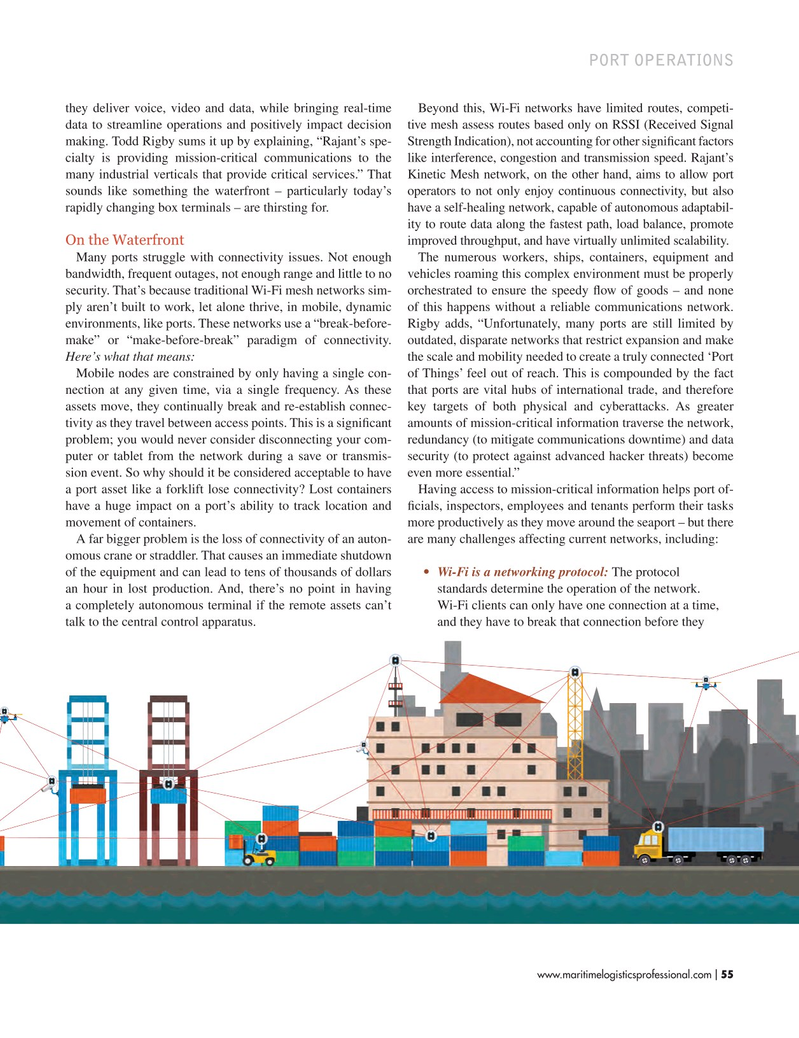
Page 55: of Maritime Logistics Professional Magazine (Sep/Oct 2017)
CONTAINER PORTS
Read this page in Pdf, Flash or Html5 edition of Sep/Oct 2017 Maritime Logistics Professional Magazine
PORT OPERATIONS they deliver voice, video and data, while bringing real-time Beyond this, Wi-Fi networks have limited routes, competi- data to streamline operations and positively impact decision tive mesh assess routes based only on RSSI (Received Signal making. Todd Rigby sums it up by explaining, “Rajant’s spe- Strength Indication), not accounting for other signifcant factors cialty is providing mission-critical communications to the like interference, congestion and transmission speed. Rajant’s many industrial verticals that provide critical services.” That Kinetic Mesh network, on the other hand, aims to allow port sounds like something the waterfront – particularly today’s operators to not only enjoy continuous connectivity, but also rapidly changing box terminals – are thirsting for. have a self-healing network, capable of autonomous adaptabil- ity to route data along the fastest path, load balance, promote
On the Waterfront improved throughput, and have virtually unlimited scalability.
Many ports struggle with connectivity issues. Not enough The numerous workers, ships, containers, equipment and bandwidth, frequent outages, not enough range and little to no vehicles roaming this complex environment must be properly security. That’s because traditional Wi-Fi mesh networks sim- orchestrated to ensure the speedy fow of goods – and none ply aren’t built to work, let alone thrive, in mobile, dynamic of this happens without a reliable communications network. environments, like ports. These networks use a “break-before- Rigby adds, “Unfortunately, many ports are still limited by make” or “make-before-break” paradigm of connectivity. outdated, disparate networks that restrict expansion and make
Here’s what that means: the scale and mobility needed to create a truly connected ‘Port
Mobile nodes are constrained by only having a single con- of Things’ feel out of reach. This is compounded by the fact nection at any given time, via a single frequency. As these that ports are vital hubs of international trade, and therefore assets move, they continually break and re-establish connec- key targets of both physical and cyberattacks. As greater tivity as they travel between access points. This is a signifcant amounts of mission-critical information traverse the network, problem; you would never consider disconnecting your com- redundancy (to mitigate communications downtime) and data puter or tablet from the network during a save or transmis- security (to protect against advanced hacker threats) become sion event. So why should it be considered acceptable to have even more essential.” a port asset like a forklift lose connectivity? Lost containers Having access to mission-critical information helps port of- have a huge impact on a port’s ability to track location and fcials, inspectors, employees and tenants perform their tasks movement of containers. more productively as they move around the seaport – but there
A far bigger problem is the loss of connectivity of an auton- are many challenges affecting current networks, including: omous crane or straddler. That causes an immediate shutdown of the equipment and can lead to tens of thousands of dollars • Wi-Fi is a networking protocol: The protocol an hour in lost production. And, there’s no point in having standards determine the operation of the network. a completely autonomous terminal if the remote assets can’t W i-Fi clients can only have one connection at a time, talk to the central control apparatus. and the y have to break that connection before they www.maritimelogisticsprofessional.com 55
I

 54
54

 56
56
